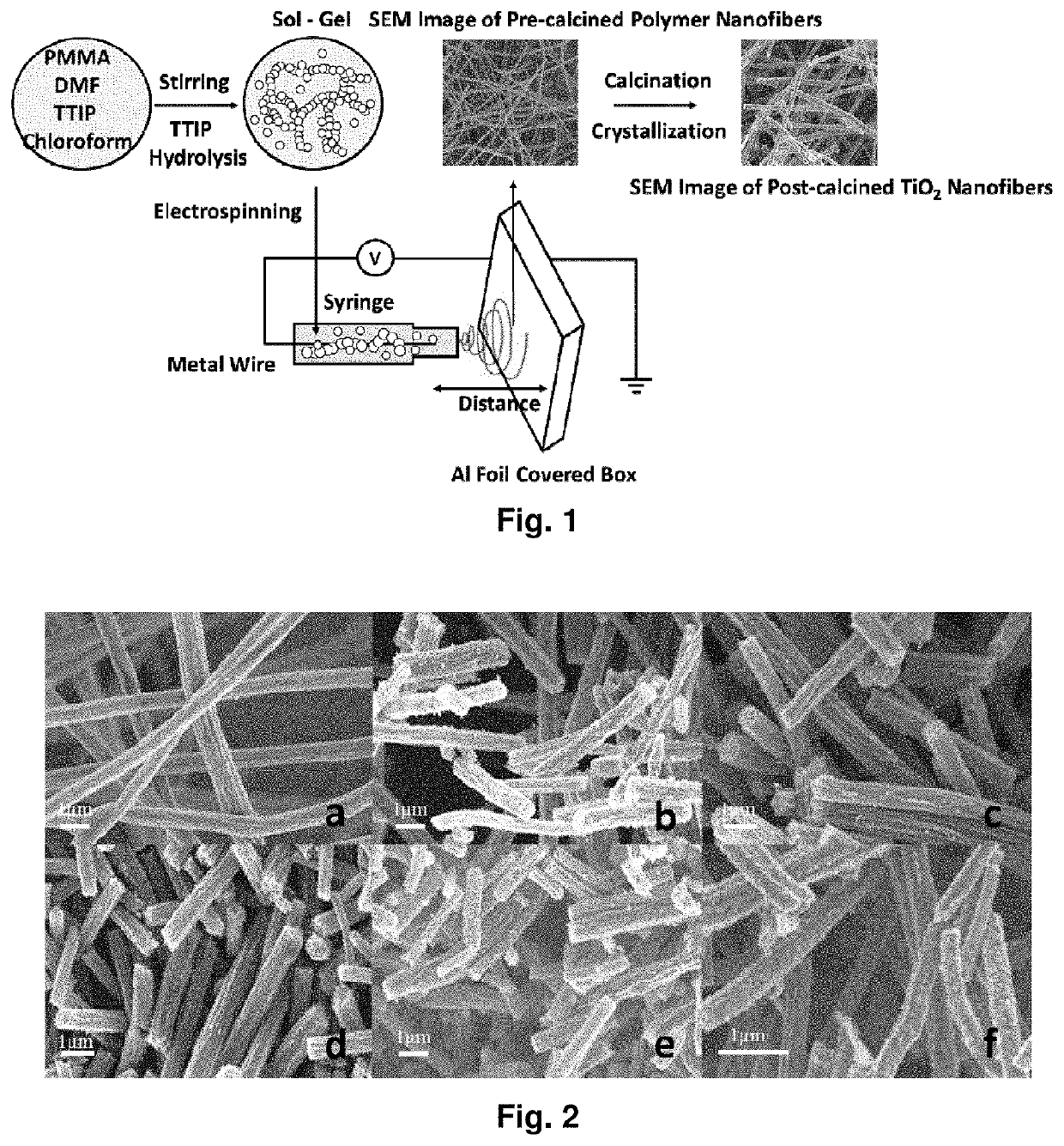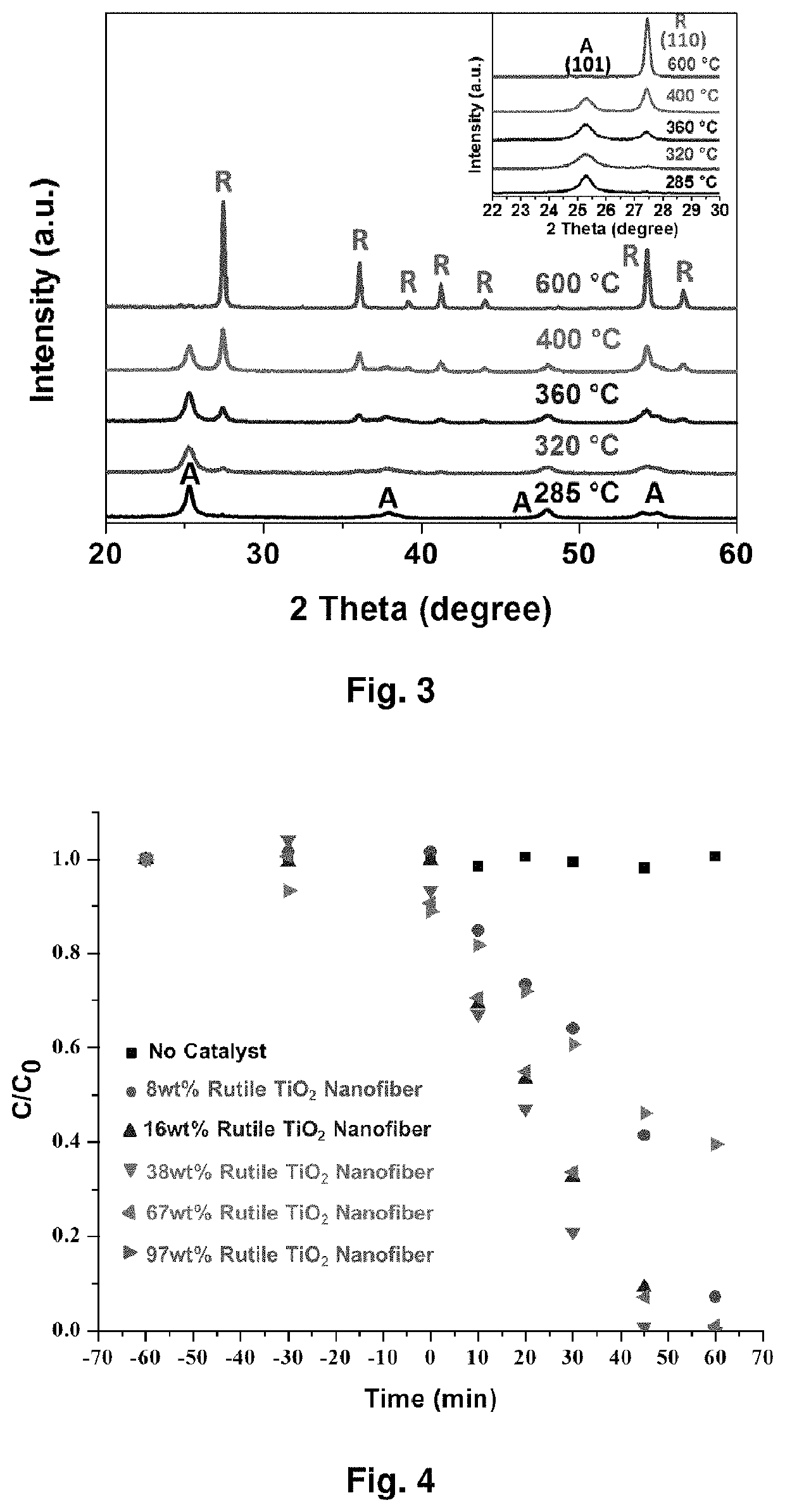Metal oxide nanofibrous materials for photodegradation of environmental toxins
a technology of metal oxide nanofibers and environmental toxins, applied in the field of photocatalytic materials, can solve the problems of limited photocatalytic activity of pure tiosub>2 /sub>fibers, and achieve the effects of enhanced photodegradation, rapid and inexpensive, and time-consuming
- Summary
- Abstract
- Description
- Claims
- Application Information
AI Technical Summary
Benefits of technology
Problems solved by technology
Method used
Image
Examples
example 1
[0160]Polymethylmethacrylate (PMMA) (Mw 960,000), titanium isopropoxide (TTIP), N,N-dimethylformamide (DMF), chloroform and phenazopyridine hydrochloride (PAP) (Mw 249.70) were all acquired from Sigma Aldrich and used as received.
[0161]1 2 mL of PAP solution with concentration of 144 μM was prepared using DI water as solvent. The solution was transferred into a 16 mL cylindrical quartz container and placed in a fume hood with the lights off. After blanking the UV-Vis Spectrophotometer with DI water in a small quartz cell, an initial reading (marked as T=−60) was taken by diluting 0.5 mL of the PAP solution with 2.0 mL of DI water. Next, 12.0 mg of the catalyst TiO2 nanofibers were added into the 12 mL PAP solution with constant stirring. After 30 and 60 minutes stirring, a 1.0 mL aliquot of the sample was taken and centrifuged for two minutes, which are recoded as sample T=−30 and T=0. Once the sample of T=0 was taken, a UV lamp was turned on at a fixed distance of 9 cm from the cen...
example 2
[0177]Nanotechnology can provide new approaches to the real time decontamination of liquids and solid surfaces. For example, photocatalytic and self-cleaning ability on the hydrophilic surface of TiO2 have found multiple uses in health, environmental and military applications. Specifically, TiO2-based electrospun fibers have great potential for use in chemical and biological decomposition [44], protective / self-cleaning clothing [40, 45], self-cleaning glass [46], and self-cleaning membranes.[47] The basic principle of photocatalytic activity is the use of incident light to excite an electron from the valence band (leaving behind a hole) to the conduction band of a semiconductor. These photoinduced charge carriers then proceed to form reactive radicals, hydroxyl radicals (A−) and super oxide radicals (D+) that attack adsorbed chemicals on the surface of the material, as shown in FIG. 8, which shows a schematic image of the photodegradation process on the surface of TiO2. Previous res...
example 3
[0185]FIG. 12 shows a schematic representation of the electrospinning process Calcination temperature influence on TiO2 phase changes. Based on the calcination temperatures, TiO2 nanofibers show different phase combination, pure anatase, pure rutile or their mixture. The X-ray diffraction (XRD) in FIG. 13 clearly shows that pure anatase phase of TiO2 shows up at relative lower temperature and it begins to transfer to rutile phase as the temperature increases. The ratios of anatase phase and rutile phase under different temperature are shown in table 1.
[0186]
TABLE 2Polymer nanofibers with different diameters preparedunder different electrospinning parametersDistancePMMA / TIPPMMAbetween Tip toPolymerDiameterPMMA:TTIPMolecularCollectorVoltageFiber(nm)(mg)Weight(cm)(kV)HumidityA638.4 ± 26.3320:640996,000182543%B761.6 ± 40.3320:640996,000112585%C 972.8 ± 134.8320:640996,000112543%
[0187]PMMA / TIP polymer fibers with different diameters can be fabricated by altering the parameters used in so...
PUM
| Property | Measurement | Unit |
|---|---|---|
| diameter | aaaaa | aaaaa |
| diameter | aaaaa | aaaaa |
| distance | aaaaa | aaaaa |
Abstract
Description
Claims
Application Information
 Login to View More
Login to View More - R&D
- Intellectual Property
- Life Sciences
- Materials
- Tech Scout
- Unparalleled Data Quality
- Higher Quality Content
- 60% Fewer Hallucinations
Browse by: Latest US Patents, China's latest patents, Technical Efficacy Thesaurus, Application Domain, Technology Topic, Popular Technical Reports.
© 2025 PatSnap. All rights reserved.Legal|Privacy policy|Modern Slavery Act Transparency Statement|Sitemap|About US| Contact US: help@patsnap.com



